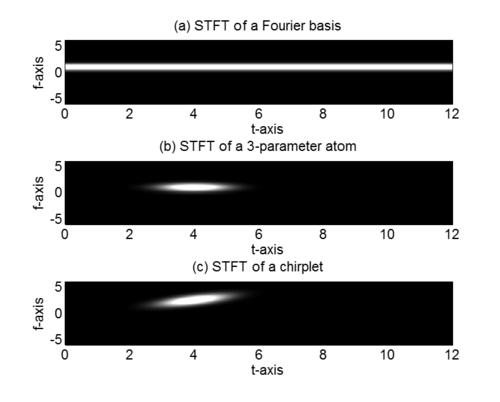無論是傅里葉級數 ,小波分析 ,或是其他的基礎,在單個基礎上的線性擴展都是不足的。傅立葉基礎在時域上提供了很弱的表現,小波不能很好地適應於具有窄高頻的傅立葉轉換。在這兩種情況下,都很難從其擴展系數中偵測和識別出信號的模樣,因為訊號在整個基礎上是被稀釋。因此,我們必須用大量的傅立葉基礎或是小波來表示具有些微誤差的整個訊號。在參考文獻中提出了一些匹配追蹤算法,已在給定基礎量時使誤差最小化。
在傅里葉級數 ,
x
(
t
)
≈
∑
m
=
1
M
a
m
⋅
e
j
2
π
m
t
/
T
{\displaystyle x(t)\approx \sum _{m=1}^{M}a_{m}\cdot e^{j2\pi mt/T}}
a
m
=
∫
0
T
x
(
t
)
e
−
j
2
π
m
t
/
T
d
t
=
⟨
x
(
t
)
,
φ
m
∗
(
t
)
⟩
⟨
φ
m
(
t
)
,
φ
m
∗
(
t
)
⟩
{\displaystyle a_{m}=\int _{0}^{T}x(t)e^{-j2\pi mt/T}dt={\frac {\langle x(t),\varphi _{m}^{*}(t)\rangle }{\langle \varphi _{m}(t),\varphi _{m}^{*}(t)\rangle }}}
在部分的時頻分析也是意圖要將訊號表示成如下的型態
x
(
t
)
≈
∑
m
=
1
M
a
m
⋅
φ
m
(
t
)
{\displaystyle x(t)\approx \sum _{m=1}^{M}a_{m}\cdot \varphi _{m}(t)}
其中,
φ
m
(
t
)
=
e
j
2
π
f
m
t
{\displaystyle \varphi _{m}(t)=e^{j2\pi f_{m}t}}
f
m
=
m
/
T
{\displaystyle f_{m}=m/T}
並且要求在M固定的情況下,將會最小化近似誤差
e
r
r
o
r
=
∫
−
∞
∞
|
x
(
t
)
−
∑
m
=
1
M
a
m
⋅
φ
m
(
t
)
|
2
d
t
{\displaystyle error=\int _{-\infty }^{\infty }|x(t)-\sum _{m=1}^{M}a_{m}\cdot \varphi _{m}(t)|^{2}dt}
將
φ
m
(
t
)
{\displaystyle \varphi _{m}(t)}
Three-parameter atoms [ 編輯 ]
x
(
t
)
≈
∑
a
t
0
,
f
0
,
σ
⋅
φ
t
0
,
f
0
,
σ
(
t
)
{\displaystyle x(t)\approx \sum a_{t_{0},f_{0},\sigma }\cdot \varphi _{t_{0},f_{0},\sigma }(t)}
φ
t
0
,
f
0
,
σ
(
t
)
=
2
0.25
σ
0.5
e
j
2
π
f
0
t
−
π
(
t
−
t
0
)
2
/
σ
2
{\displaystyle \varphi _{t_{0},f_{0},\sigma }(t)={\frac {2^{0.25}}{\sigma ^{0.5}}}e^{j2\pi f_{0}t-\pi (t-t_{0})^{2}/\sigma ^{2}}}
當
φ
t
0
,
f
0
,
σ
{\displaystyle \varphi _{t_{0},f_{0},\sigma }}
a
t
0
,
f
0
,
σ
{\displaystyle a_{t_{0},f_{0},\sigma }}
匹配追求過程
三個參數如下:
t
0
{\displaystyle t_{0}}
f
0
{\displaystyle f_{0}}
σ
{\displaystyle \sigma }
[ 編輯 ]
x
(
t
)
≈
∑
a
t
0
,
f
0
,
σ
,
η
⋅
φ
t
0
,
f
0
,
σ
,
η
(
t
)
{\displaystyle x(t)\approx \sum a_{t_{0},f_{0},\sigma ,\eta }\cdot \varphi _{t_{0},f_{0},\sigma ,\eta }(t)}
φ
t
0
,
f
0
,
σ
,
η
(
t
)
=
2
0.25
σ
0.5
e
j
2
π
(
f
0
t
+
η
/
2
t
2
)
−
π
(
t
−
t
0
)
2
/
σ
2
{\displaystyle \varphi _{t_{0},f_{0},\sigma ,\eta }(t)={\frac {2^{0.25}}{\sigma ^{0.5}}}e^{j2\pi (f_{0}t+\eta /2t^{2})-\pi (t-t_{0})^{2}/\sigma ^{2}}}
四個參數如下:
t
0
{\displaystyle t_{0}}
f
0
{\displaystyle f_{0}}
σ
{\displaystyle \sigma }
η
{\displaystyle \eta }
在不同的基礎的短時距傅立葉轉換
x
(
t
)
≊
∑
n
,
T
,
Ω
,
t
0
,
f
0
a
n
,
T
,
Ω
,
t
0
,
f
0
ψ
n
,
T
,
Ω
(
t
−
t
0
)
e
j
2
π
f
0
t
{\displaystyle x(t)\approxeq \sum _{n,T,\Omega ,t_{0},f_{0}}a_{n,T,\Omega ,t_{0},f_{0}}\psi _{n,T,\Omega }(t-t_{0})e^{j2\pi f_{0}t}}
S. G. Mallat and Z. Zhang, 「Matching pursuits with time-frequency dictionaries,」 IEEE Trans. Signal Processing, vol. 41, no. 12, pp. 3397–3415, Dec. 1993.
A. Bultan, 「A four-parameter atomic decomposition of chirplets,」 IEEE Trans. Signal Processing, vol. 47, no. 3, pp. 731–745, Mar. 1999.
C. Capus, and K. Brown. "Short-time fractional Fourier methods for the time-frequency representation of chirp signals," J. Acoust. Soc. Am. vol. 113, issue 6, pp. 3253–3263, 2003.
Jian-Jiun Ding, Time frequency analysis and wavelet transform class note, Department of Electrical Engineering, National Taiwan University (NTU), Taipei, Taiwan, 2016.
Jian-Jiun Ding, Time frequency analysis and wavelet transform class notes, Graduate Institute of Communication Engineering, National Taiwan University (NTU), Taipei, Taiwan, 2017. 


















